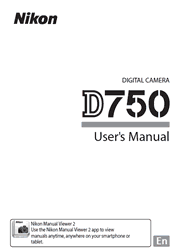For those who find inspiration everywhere, who switch between stills and video without missing a beat, who want the look only a full-frame DSLR can achieve and who love sharing their shots, the D750 is the tool to unleash your artistry. With features inspired by D4S and D810, the D750 brings dazzling image quality, cinematic video capabilities and pro-inspired handling in a nimble design with a tilting Vari-angle LCD and built-in Wi-Fi connectivity. Enthusiasts upgrading from a DX-format DSLR will marvel at the D750′s full-frame performance. Pros seeking a primary or secondary camera for fast-paced shoots will appreciate the D750′s familiar handling and speed. And filmmakers looking for a compact DSLR to bring a production to life or to capture B-Roll will find the D750 a perfect fit. The D750 is a thrilling centerpiece of an exceptional imaging system.
Introduction
Getting to Know the Camera
Camera Menus
First Steps
Basic Photography and Playback
“Point-and-Shoot” Photography (Auto and Auto (flash off) Modes)
Matching Settings to the Subject or Situation (Scene Mode)
Portrait
Landscape
Child
Sports
Close Up
Night Portrait
Night Landscape
Party/Indoor
Beach/Snow
Sunset
Dusk/Dawn
Pet Portrait
Candlelight
Blossom
Autumn Colors
Food
Special Effects
Night Vision
Color Sketch
Miniature Effect
Selective Color
Silhouette
High Key
Low Key
Options Available in Live View
Live View Photography
Focus
Manual Focus
Using the i Button
The Live View Display: Live View Photography
The Information Display: Live View Photography
Movie Live View
Indices
Using the i Button
The Live View Display: Movie Live View
The Information Display: Movie Live View
Image Area
Taking Photos During Movie Live View
Viewing Movies
Editing Movies
P, S, A, and M Modes
P: Programmed Auto
S: Shutter-Priority Auto
A: Aperture-Priority Auto
M: Manual
User Settings: U1 and U2 Modes
Saving User Settings
Recalling User Settings
Resetting User Settings
Release Mode
Choosing a Release Mode
Self-Timer Mode
Mirror up Mode
Image Recording Options
Image Area
Image Quality and Size
Using Two Memory Cards
Focus
Autofocus
Manual Focus
ISO Sensitivity
Auto ISO Sensitivity Control
Exposure
Metering
Autoexposure Lock
Exposure Compensation
White Balance
Fine-Tuning White Balance
Choosing a Color Temperature
Preset Manual
Image Enhancement
Picture Controls
Preserving Detail in Highlights and Shadows
Flash Photography
Using the Built-in Flash
Flash Compensation
FV Lock
Remote Control Photography
Using an Optional ML-L3 Remote Control
Wireless Remote Controllers
Other Shooting Options
Viewfinder Photography: The i Button
Two-Button Reset: Restoring Default Settings
Bracketing
Multiple Exposure
Interval Timer Photography
Time-Lapse Photography
Non-CPU Lenses
Location Data
More on Playback
Viewing Pictures
Photo Information
Taking a Closer Look: Playback Zoom
Protecting Photographs from Deletion
Deleting Photographs
Connections
Installing ViewNX 2
Using ViewNX 2
Printing Photographs
Viewing Photographs on TV
Wi-Fi
What Wi-Fi Can Do for You
Accessing the Camera
Selecting Pictures for Upload
Menu Guide
Defaults
The Playback Menu: Managing Images
The Photo Shooting Menu: Photo Shooting Options
The Movie Shooting Menu: Movie Shooting Options
Custom Settings: Fine-Tuning Camera Settings
The Setup Menu: Camera Setup
The Retouch Menu: Creating Retouched Copies
My Menu / Recent Settings
Technical Notes
Compatible Lenses
Optional Flash Units (Speedlights)
Other Accessories
Caring for the Camera
Caring for the Camera and Battery: Cautions
Available Settings
Exposure Program (Mode P)
Troubleshooting
Error Messages
Specifications
Approved Memory Cards
Memory Card Capacity
Battery Life
Lenses That May Block the Built-in Flash and AF-Assist Illuminator
Index
